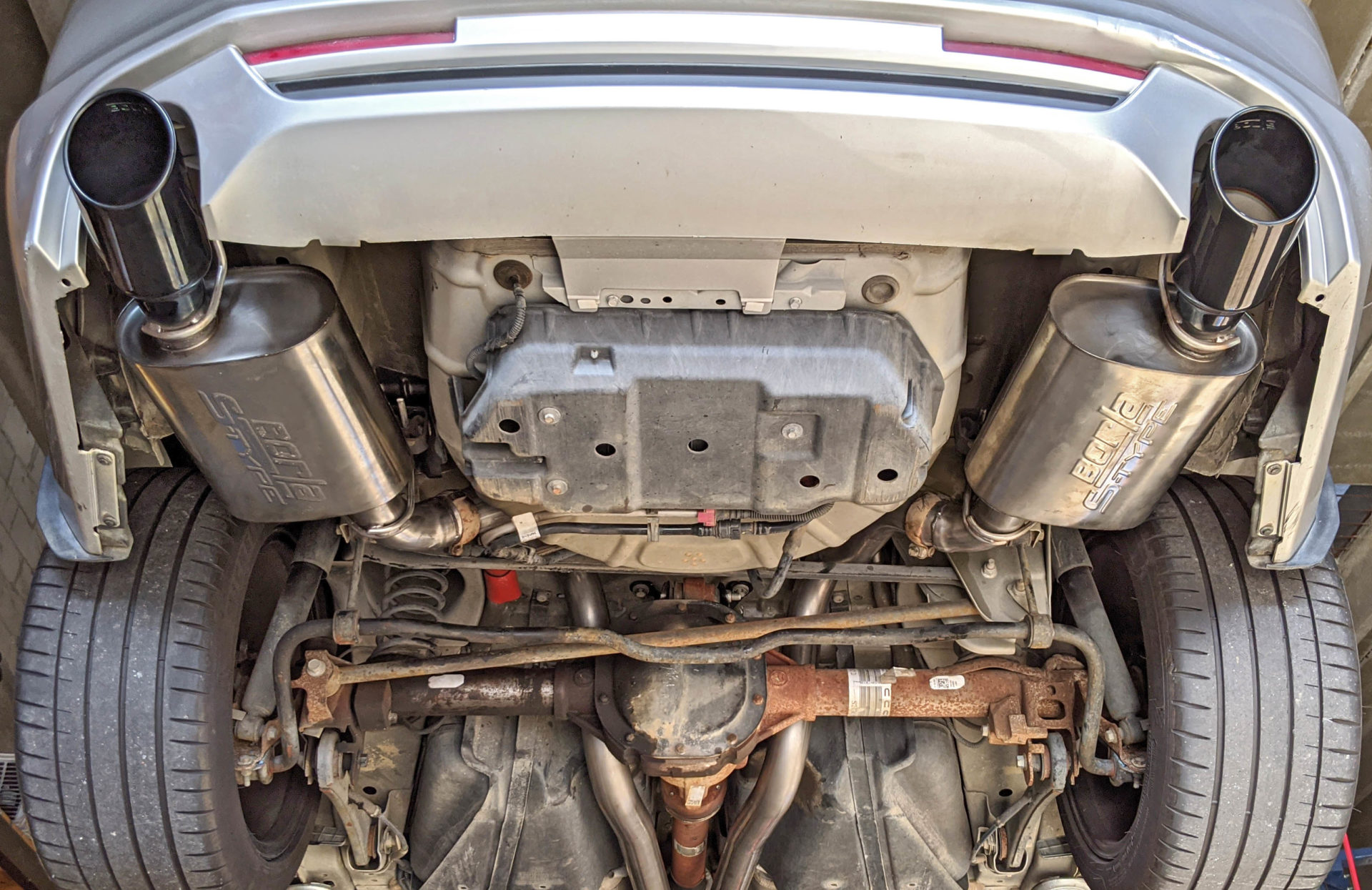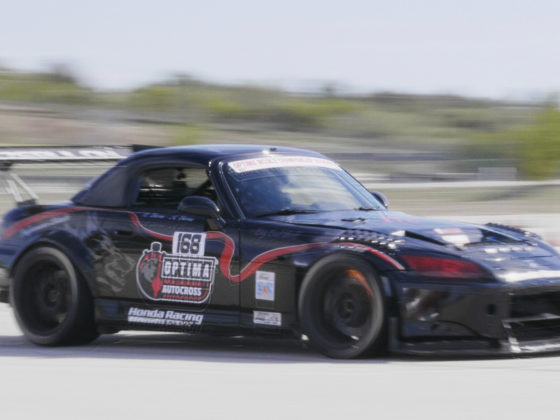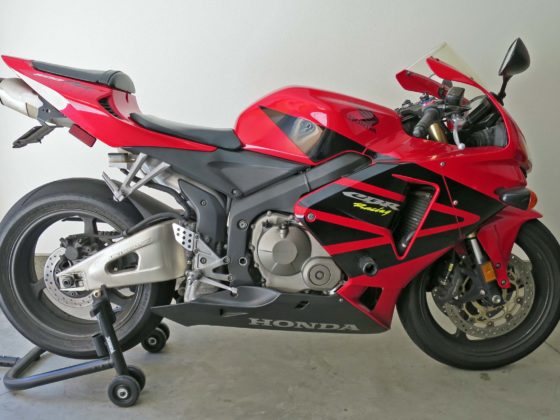 Compared to when the car was stock (BLUE), the retuned K&N “Race” intake, 2018+ Gen-3 intake manifold, and Borla exhaust setup (RED) matches the stock setup’s low-end torque before taking off above 4,400rpm and screaming to the new 7,500 RPM redline.
Compared to when the car was stock (BLUE), the retuned K&N “Race” intake, 2018+ Gen-3 intake manifold, and Borla exhaust setup (RED) matches the stock setup’s low-end torque before taking off above 4,400rpm and screaming to the new 7,500 RPM redline.
 Compared to a similarly modified Gen-1 Coyote with a stock intake manifold (BLUE), the 2018+ intake manifold (RED) puts down an average of 6-8 WHP more from 4,600-7,500rpm. On a road course or drag strip where the RPMs will rarely ever be below 4,500 RPM, the 2018+ intake manifold is the clear winner. For street use, the stock intake manifold is better when shifting before 4,500 RPM.
Compared to a similarly modified Gen-1 Coyote with a stock intake manifold (BLUE), the 2018+ intake manifold (RED) puts down an average of 6-8 WHP more from 4,600-7,500rpm. On a road course or drag strip where the RPMs will rarely ever be below 4,500 RPM, the 2018+ intake manifold is the clear winner. For street use, the stock intake manifold is better when shifting before 4,500 RPM.
 Compared to a stock 2012 BOSS 302 (GREEN), our new setup (RED) nearly matches the infamous 444 BHP BOSS 302 from 4,600-7,500 RPM.
Compared to a stock 2012 BOSS 302 (GREEN), our new setup (RED) nearly matches the infamous 444 BHP BOSS 302 from 4,600-7,500 RPM.
 Our Gen-1 with the 2018+ intake manifold, K&N intake, Borla exhaust and a tune (RED) holds its own against our own 2016 Gen-2 Mustang with the Ford Performance “Power Pack 2” kit that uses the GT350’s larger throttle body and intake, mated to the stock Gen-2 intake manifold (BLUE).
Our Gen-1 with the 2018+ intake manifold, K&N intake, Borla exhaust and a tune (RED) holds its own against our own 2016 Gen-2 Mustang with the Ford Performance “Power Pack 2” kit that uses the GT350’s larger throttle body and intake, mated to the stock Gen-2 intake manifold (BLUE).
We can see the Gen-1/2 style intake manifold choking off at 6,600 RPM while our build’s 2018+ manifold (RED) keeps pulling and matches the 2016 Mustang with the “Power Pack 3” (GREEN). The PP3 adds the 8,250-RPM GT350 intake manifold to the throttle body and air intake, and it’s obvious by the lack of torque from 3,700-6,200 RPM that this manifold was tuned to run over 8,000 RPM. Our old Gen-1 setup actually has more area under the curve and outperforms the Gen-2 PP3 package to a 7,500 RPM redline. However, if the redline was raised to 8,000 RPM, PP3 may show an advantage.
 Finally, we compare our budget build (RED) to a stock 2018+ Gen-3 Mustang (BLUE). Despite the same intake manifold, the actual Gen-3’s direct injection, 84cc larger displacement, and 12:1 compression ratio (vs 11:1) makes an average of 20 LB-FT of torque more from idle to 5,700 RPM. Our old Gen-1 closes the gap to redline but just comes up a bit short to the 460 BHP monster.
Finally, we compare our budget build (RED) to a stock 2018+ Gen-3 Mustang (BLUE). Despite the same intake manifold, the actual Gen-3’s direct injection, 84cc larger displacement, and 12:1 compression ratio (vs 11:1) makes an average of 20 LB-FT of torque more from idle to 5,700 RPM. Our old Gen-1 closes the gap to redline but just comes up a bit short to the 460 BHP monster.
 From behind the wheel, we were very satisfied with the sound of the Borla S-Type Cat-Back Exhaust. The car roars to life with an aggressive sound at startup that’s not as loud as a stock GT350 or GT500, which are loud enough to upset neighbors and convince some police officers that the exhausts aren’t stock.
From behind the wheel, we were very satisfied with the sound of the Borla S-Type Cat-Back Exhaust. The car roars to life with an aggressive sound at startup that’s not as loud as a stock GT350 or GT500, which are loud enough to upset neighbors and convince some police officers that the exhausts aren’t stock.
On the road, this exhaust delivers everything we were looking for. Zero drone and quiet enough to hold conversations on the highway at light loads and RPM, but when revving the car out, the exhaust belts out a deeper burbly note that makes the car engaging and fun to drive, begging to be taken to redline.
I’ve always liked the balance of Borla’s more tame offerings like the Touring and S-Type over the louder ATAK exhausts. If we were planning to delete the cats or install long-tube headers, I would choose the quieter “Touring” mufflers. Since that was not our initial intention, we are extremely happy with the overall balance between performance and sound the S-Type cat-back delivers with the stock headers and cats.
We can now say that we are fans of Borla exhausts on every generation of Coyote Mustang. The S-Type Cat-Back exhaust gave us a weight reduction of over 30 LBS, while giving the car a more aggressive character and improved sound without being obnoxious. With the objective of 400 WHP complete, we will turn to the suspension to get our “Budget 400 WHP Track Car” to perform like a track star for as little money as possible. Stay tuned for our next installment!
Quick Reference:
Page 1 – Stock Exhaust & Borla S-Type
Page 2 – Stock Exhaust Analysis
Page 3 – Crossover Pipe Removal vs Borla
Page 4 – Mid Pipe & Muffler Removal vs Borla
Page 5 – Borla Installation
Page 6 – Borla Installed
Page 7 – Dyno Borla & K&N Airbox Lid On vs Off
Page 8 – Dyno JLT vs K&N Intake. New PBD Tune Dyno
Page 9 – Dyno Overlays: Stock, Tuned Stock Intake Manifold, 2016 Mustang, 2018 Mustang, 2012 Boss 302, Conclusion




14 comments
Great write up with usable comparisons. Do race mustangs tend to stick with duals or go to single for weight?
The old FR500Cs had dual throttle bodies, but most Mustangs now use single round TBs for simplicity.
Really enjoy your perspective on so many things and this build is enjoyable to follow.
Page three, second paragraph first sentence says intake manifold, but probably meant exhaust manifold.
You got me, I got you 😉
Thanks for the feedback!
Thanks for the articles! Stay safe.
Very timely article for me, as I’ve been looking at 11-14 GTs as a fair weather DD, and part time track car. My brother has 12 Boss, but a TP/Brembo GT fits my needs and budget. Is there a Part 1 posted somewhere?
Thanks for posting. Looking forward to Part 4…
what was the alleged speed for the intake on road lid on test? and what gear?
I used nothing but Borla Exhaust on all the BDX Mustangs we made from 2007 to 2009. Love it. Trivia, in 1988 my Fox was the mule for the 1st Mustang Borla system. Alex borrowed it and I drove his T-bird for about 2 weeks.
That’s really cool historical fact! I have Borla on my Tundra tow vehicle, nice mellow V8 rumble in Touring spec. And got an S-Type coming for my Turbo 4 Camaro 1LE, which needs an exhaust note desperately.
Great information, I own a 2014 GT Mustang that I track 3 to 4 times a year, I have done some suspension and brake mods but no engine mods yet.
Really appreciate how methodical and well thought out all your articles are Billy!
Looking forward to seeing the continued progression of this car. Are you planning to road test the airbox lid comparison as described on Page 7?
Factory exhaust is 409ss not mild steel. Pretty much every factory exhaust since the 90s is 409ss. You will find steel components like flanges and hangers, but piping and mufflers are 409ss. Some later stuff is aluminized coated 409ss like the back half of Mopar exhausts, pickup truck tailpipes, generally anything somewhat visible from the outside of the vehicle.
Long tube headers, albeit expensive, will indeed provide for a substantial increase in RWHP….and RWTQ. You would be up to 450 rwhp with LT’s….and that is a bunch. But that would require either no cats..and an X….or a hi-flow catted X. Then the appropriate mufflers, to tame the noise/any drone. Resonators, just before the rear axle, would also tame noise down, if the mufflers didn’t do the job.
We didn’t want the car to be obnoxiously loud, which long tube headers often do. The car is already borderline with cats and the quietest muffler Borla makes. We are happy with the sound and performance with the current package, meeting our performance goals.